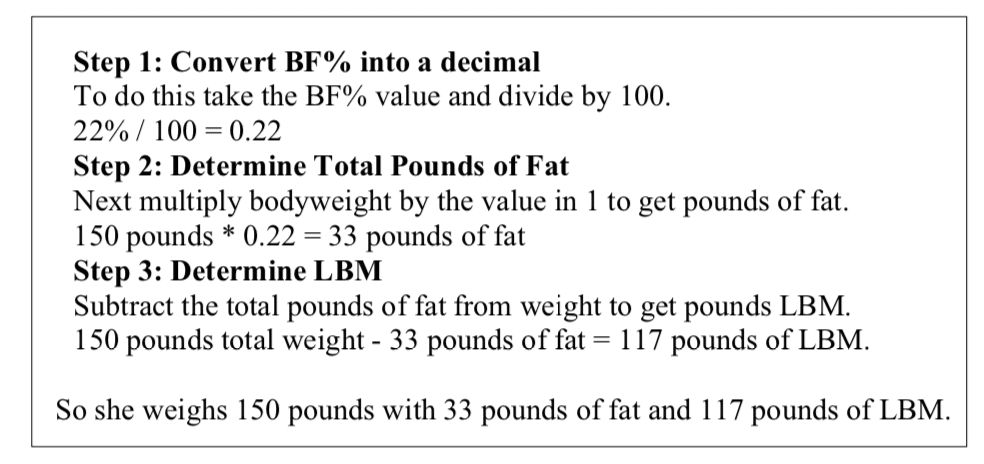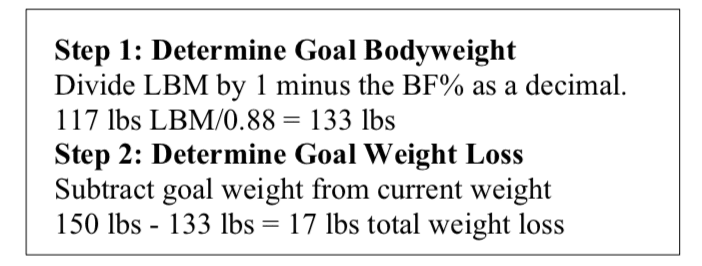In the first part of this guide, I examined what body composition means where I looked at the different components of the human body and how they integrate to determine body composition. Following up from that piece, I want to talk more about body fat percentage (BF%), what the numbers tell you and how they can be used to determine how changes in body composition will affect the overall percentage.
Table of Contents
Body Composition Calculation
As I discussed in the first part of this guide, when you know the amounts of fat and lean mass present in the body, you can calculate body fat percentage. I’ll discuss the different methods available to do this later in the guide.
For the time being let’s assume I have a magic wand which I can wave to determine someones body fat percentage. With those values let me show you two different body composition calculations that can be done.
Calculation 1: Determining Body Composition
First let me show you how to calculate the pounds of fat and lean body mass (LBM) based on your weight and BF%.
I’ve shown the calculations below for a woman weighing 150 lbs at 22% bodyfat.
Calculation 2: Determining BF%
The same calculation can be done in reverse to determine BF% if total LBM and total fat mass are known. I’ve shown this below for a woman who is carrying 30 lbs of fat and 120 lbs of LBM.  Mind you, it’s fairly uncommon to have the pounds of fat and LBM without knowing BF%. Rather, that second calculation can be used to examine a related topic.
Mind you, it’s fairly uncommon to have the pounds of fat and LBM without knowing BF%. Rather, that second calculation can be used to examine a related topic.
How Do Changes in Body Composition Affect Body Fat Percentage?
Since folks usually want to alter their body fat percentage, it’s instructive to look at how changes in either total fat mass or lean body mass will change overall body fat percentage. I want to look at the situation where our hypothetical athlete either loses pure fat, gains pure muscle, or gains muscle while losing fat.
So let me start with the woman from calculation 1 who weighs 150 lbs at 22% bodyfat with 33 lbs of body fat.
First I’ll look at moderate changes of either a 5 lb gain in LBM or a 5 lb loss of fat with no other change. I’ll also look at what happens if someone gains 5 lbs of LBM while losing 5 lbs of fat (this isn’t common and I’m showing it mainly to make a point). I’ll also look at the extremes of gaining 20 lbs of LBM (roughly a woman’s maximum potential) or losing the same 20 pounds of fat. Finally, just for illustration, I’ll show a 10 lb loss of fat.
Perhaps the major thing to take from the above chart is that losing fat has an enormously large impact on BF% than gaining the same amount of muscle. For example, losing 5 lbs of fat lowers BF% by 2.7% while gaining 5 lbs of muscle only lowers it by 0.7%. Note that doing both at the same time ends up summing the effect of each with a BF% being reduced by 3.3% (2.7% + 0.7% = 3.4%). Not that this is particularly easy to do.
I bring this up as it’s often recommended that people gain muscle to lower their body fat percentage. While this is true, it works far less efficiently than losing the same amount of fat. There is also the issue of the time involved. Losing 5 pounds of fat can be done much faster than gaining the same 5 pounds of muscle. When reducing BF% is the goal, losing fat (while maintaining or, hopefully, gaining a small amount of muscle) is the best way.
I’d also note that you don’t have to do the calculations as if pure fat loss or muscle gain is occurring. You can plug any changes you want into the above values to see how varying changes in fat mass and LBM will affect the overall body fat percentage.
Calculating Goal Fat Loss to Reach a Specific BF%
A question that comes up quite a bit is how much fat someone will need to lose to reach a certain body fat percentage, given that they know where they are now. Assuming you have starting numbers for fat mass and total weight, there is a fairly easy calculation to do this. I’d note that this calculation assumes that the total weight lost is fat mass and that there is no muscle loss. This isn’t always a good assumption.
Calculation 3: Determining Goal Bodyweight and Fat Loss
Once again, I’ll use the woman from above who is starting at 150 lbs and 22% bodyfat with 117 lbs of LBM. She wants to get to 12% bodyfat. The calculation is shown below.

So she has to lose 17 pounds of pure fat with zero muscle loss to reach her goal of 12% bodyfat. This would put her at a (theoretical) finishing weight of 133 lbs (150 lbs – 17 lbs). I say theoretical since she will have lost some non-muscle LBM such as water on the way down in addition to the potential loss of small amounts of muscle loss. Her realistic finishing weight might be 10% less than that or closer to 130 lbs.
The Guide to Body Composition continues in Body Composition – Numbers
Similar Posts:
- A Guide to Body Composition
- Women’s Muscular Potential
- 4 Reasons to Change Body Composition
- Muscle Loss While Dieting to Single Digit Body Fat Levels
- The Impact of Bodyfat Percentage on Body Composition Changes

No matter how many time I perform the calculations, the numbers always seem to trip me up. Thanks for presenting this fairly complicated concept in easy to understand terms.
“Goal Weight = Current Lean Body Mass / (1-Goal Body Fat percentage as a decimal)”
Clear concise and easy to understand – well done!
It would be nice to have the magic wand you referred to above to establish the correct base lines. Since I can’t seem to find one on the market, what do you recommend in the meantime? I seem to remember that you mentioned awhile ago that you didn’t like the tanita machines for calculating body fat percentage.
I’m not very good at numbers. 🙂
Hammacher and Schlemmer has recently begun selling a body composition scale that they tout as being “the best” . It has a hand held “piece” as well as the usual scale apparatus that you stand on. Might this be a significant improvement over the models that only have the bit that you stand on? I’m curious because I have one of those and I do monitor my LBM% and invariably I find that I lose a significant amt of LBM in porportion to my total loss (upwards of 1/3). I’m quite concerned by that ratio but know that I’m developing more muscle because I can feel it, and am stronger.
Comments? Suggestions?
BIA, by and large, is garbage in my experience.
The method is drastically affected by hydration and not terribly accurate so far as I’m concerned. if you drink a big glass of water or take a big piss, the values will change. They are expensive garbage as far as I’m concerned.
what does the 1 in the 1-target body weight stand for?
It doesn’t stand for anything, it’s just how the math is done.
Great simple calculation! Thanks for providing it.
@lylemcd
@Dave D
1=100%
Goal Weight = 180lbs / (100% – 5%) = 180/95% = 189lbs
I tried using this calculation and my goal weight was an increase
With such detailed information on what you did, the answer is a mallard. Should I just guess what numbers you put in or what you were trying to determine? Because the equation works. Unless you use it wrong.
how to calculate body water percentage if you have age , weight , height , body fat percentage , subcutnaeous fat percentage , lbm ?? any formula to find out water percentage of body ..using omron bca 701
None that I am aware of. Supposedly the new Tanita scales do this but, meh. Why is this relevant?